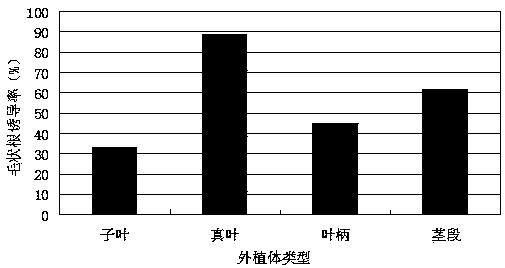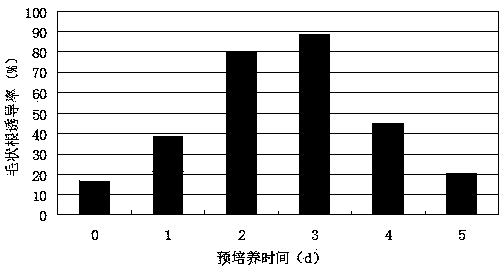Efficient inducing method of rhizoma coptidis hairy roots
A technology of hairy root and Coptis chinensis is applied in the biological field to achieve the effects of reducing browning rate and mortality, enhancing antioxidant capacity and improving stress resistance
- Summary
- Abstract
- Description
- Claims
- Application Information
AI Technical Summary
Problems solved by technology
Method used
Image
Examples
Embodiment 1
[0039] A high-efficiency induction method of Coptis chinensis hairy roots, specifically comprising the steps of:
[0040] S1. Acquisition of sterile tissue culture seedlings
[0041] Select robust Coptis chinensis plants, wash them with flowing tap water for 30 minutes, cut the stems with buds on the plants in a purification workbench, wash them with sterile water for 2 to 3 times, soak them in 75% ethanol for 30 to 50 seconds, and wash them off with sterile water. Finally, soak in 0.2% mercuric chloride for 8-10 minutes, wash away the residue with sterile water; place the sterilized stems on sterile filter paper to absorb the moisture on the surface, and then inoculate them with 0.5mg / LNAA, 0.1mg / L6- On the MS solid medium of BA, culture under the conditions of temperature 22°C, light intensity 1800lx, and light time 13h / d until they grow into sterile tissue culture seedlings with true leaves.
[0042] S2. Pre-cultivation of explants
[0043] Under aseptic conditions, cut t...
Embodiment 2
[0050] Example 2 Effect of Explant Types on the Induction Rate of Coptis Rhizoma Hairy Roots
[0051] Under sterile conditions, the cotyledons, true leaves, petioles and stems of Coptidis aseptic tissue cultured seedlings were cut into 0.5 cm 2 The small piece of is used as explant, and other operation steps are all the same as embodiment 1, compares the influence of explant type on Coptis chinensis hairy root induction rate, the result is as follows figure 1 shown.
[0052] test results( figure 1 ) showed that the type of explant had a significant effect on the induction rate of Coptidis hairy roots. In the experiment, the order of induction ability of four kinds of explants to hairy root was: true leaf>stem segment>petiole>cotyledon. Since the transformation of Agrobacterium rhizogenes only occurs in the S phase of cell division (that is, the DNA synthesis phase), vigorously growing tissues and organs—true leaves of sterile tissue culture seedlings—are more likely to in...
Embodiment 3
[0053] Example 3 Effect of preculture on induction rate of Coptis chinensis hairy roots
[0054] 1) Effect of pre-culture time on induction rate of Coptis chinensis hairy roots
[0055] The pre-cultivation time of the explants in Example 1 is set to 0, 1, 2, 3, 4, 5d, and other operation steps are all the same as in Example 1, and the influence of the pre-culture time on the induction rate of Coptis chinensis hairy roots is compared, the result Such as figure 2 shown.
[0056] test results( figure 2 ) showed that the pre-culture time had a significant effect on the induction rate of Coptis chinensis hairy roots. Compared with no pre-culture (pre-culture time is 0d), the induction rate of Coptis chinensis hairy roots has been improved after pre-culture. Within 1-3 days of pre-culture, the induction rate of Coptis chinensis hairy roots increased with the prolongation of pre-culture time, and the induction rate was the highest at 3 days, and then gradually decreased after 3...
PUM
 Login to View More
Login to View More Abstract
Description
Claims
Application Information
 Login to View More
Login to View More - R&D
- Intellectual Property
- Life Sciences
- Materials
- Tech Scout
- Unparalleled Data Quality
- Higher Quality Content
- 60% Fewer Hallucinations
Browse by: Latest US Patents, China's latest patents, Technical Efficacy Thesaurus, Application Domain, Technology Topic, Popular Technical Reports.
© 2025 PatSnap. All rights reserved.Legal|Privacy policy|Modern Slavery Act Transparency Statement|Sitemap|About US| Contact US: help@patsnap.com



